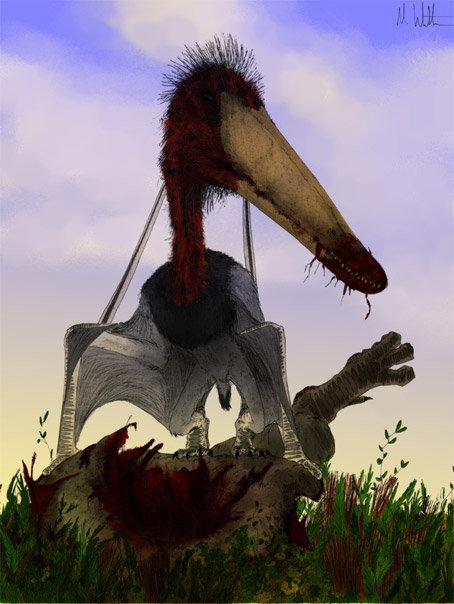[Recent Entries][Archive][Friends][User Info]
June 4th, 2014
| June 4th, 2014 | |
|---|---|
| 07:46 pm [industrialterro] [Link] |
Istiodactylus Istiodactylus is a genus of a medium sized pterosaurs from the early Cretaceous period. Istiodactylus were moderately large pterosaurs. Correcting earlier estimates of a length of fifty-six centimetres, Mark Paul Witton in 2012 concluded that the skull of one specimen, NHMUK R3877, was forty-three centimetres long. The maximum wingspan was probably about 4.3 metres (14.1 ft), making the largest individuals roughly half the size of the largest Pteranodon. Because of the flat, rounded shape of the snout, Istiodactylus is sometimes referred to as a "duck-billed pterosaur". However, unlike ducks, they had teeth. These triangular teeth were laterally compressed, an adaptation for slicing flesh, and interlocked tightly in the closed jaws. The skull was relatively short, with most teeth concentrated in the blunt front tip of the jaws. Witton's 2012 study proposed that Istiodactylus were primarily scavengers. In 1887 Harry Govier Seeley named the remains of a fossil pelvis discovered on the Isle of Wight, Ornithodesmus cluniculus, thinking it was a bird. In 1901 he considered that it might have been a pterosaur. In 1913 Reginald Walter Hooley named a second species, Ornithodesmus latidens, for some definitively pterosaurian material, found in the Vectis Formation. The holotype was BMNH R 0176, a partial skeleton. The specific name means "broad tooth" in Latin. The type species of the genus Ornithodesmus, however, was in the 1980s discovered to be based on bones belonging to a dinosaur, which meant a new genus had to be named for O. latidens. This species was assigned to its own genus Istiodactylus by Stafford Howse, Andrew Milner, and David Martill in 2001. The genus name is derived from Greek istion, "sail" and daktylos, "finger", referring to the fact that the wing of pterosaurs is formed by a membrane attached to a wingfinger. Howse et al. in 2001 created for Istiodactylus its own family Istiodactylidae. In 2006 a second species, I. sinensis from China, has been named, its specific name referring to China. Its holotype is NGMC 99-07-011, a partial skeleton of a subadult individual. It was much smaller than I. latidens, its dimensions being 63% of the larger species, thus about a quarter in weight. In 2006 Lü Jun-Chang et al. concluded I. sinensis was a junior synonym of the istiodactylid Nurhachius. Mark Witton has proposed it may be a synonym of Liaoxipterus. Istiodactylidae is a small family of pterosaurs. This family was named in 2001 after the type genus Istiodactylus was discovered not to be a member of the genus Ornithodesmus. Remains of taxa that can be confidently assigned to Istiodactylidae have been found in the UK and China, in rocks dating from the Early Cretaceous period (Barremian to Aptian stage). Arbour and Currie (2011) described Canadian Gwawinapterus beardi as a member of Istiodactylidae living in the late Cretaceous (upper Campanian stage); however, Witton (2012) suggested the tooth replacement pattern in this animal does not match that of pterosaurs, suggesting that the species might be non-pterosaurian. Additional research suggested that the species was in fact a fish. The earliest known species might be Archaeoistiodactylus linglongtaensis, from the Middle Jurassic of China; however, it also has been suggested that the holotype specimen of this species might actually be a poorly preserved specimen of Darwinopterus. Hongshanopterus, a supposed istiodactylid from China, has been reclassified as a non-istiodactylid member of Ornithocheroidea of uncertain phylogenetic placement by Witton (2012). Istiodactylids were medium sized pterosaurs with flat, rounded jaws similar to that of a duck. They had small teeth lining their jaws, however. Крылатые рептилии мелового периода были не хищниками, а самыми настоящими падальщиками наподобие современных грифов. Питались они главным образом мертвыми динозаврами. Неожиданное открытие сделал доктор Марк Уиттон из Портсмутского университета. Он решил тщательно изучить останки птерозавра Istiodactylus latidens, найденного в 1904 году на острове Уайт, и с тех пор лежавшего на витрине Лондонского музея естественной истории. Поскольку до сих пор изученными оставались лишь черепная коробка и ветви челюсти этого животного, у палеонтологов сложилось мнение о его узкой, низкой и длинной голове. Как показало новое исследование, голова истиодактилуса, напротив, была высокой, широкой и короткой. При этом кости обеспечивали надежное крепление чудовищной шейной мускулатуре, позволявщей крылатому ящеру легко отрывать куски плоти с туш крупных животных. В то время как зубы Istiodactylus latidens были острыми и приспособленными для разрезания мяса, его скулы оказались неожиданно тонкими. Их толщина едва достигает шести миллиметров при общей высоте черепа до 45 сантиметров. Ящер легко мог сломать себе кости, если бы вступил в схватку даже с не слишком сильным противником, сообщает The Daily Mail. Именно это обстоятельство позволило доктору Уиттону сделать предположение о том, что добыча истиодактилусов никогда не сопротивлялась, а просто лежала на одном месте. "Современные птицы-падальщики имеют схожую конструкцию черепа, обладающую как
сильными, так и слабыми компонентами. Поедание мертвой плоти позволяет птицам-падальщикам
практически полностью контролировать процесс питания, поэтому они могут
позволить себе иметь несколько слабых участков, расположенных вдоль челюсти, не
беспокоясь о том, что их можно сломать при укусе, – рассказал палеонтолог. –
Широкий и высокий череп Istiodactylus latidens позволяет прикрепить
мощный набор шейных мышц, что указывает на сильную шею, которая является еще
одним общим качеством птиц-падальщиков, которые используют свои сильные шеи, чтобы
растаскивать части трупа. Если сопоставить данные обстоятельства с режущими
зубами, то все эти свойства являются хорошим доказательством падалеядного образа жизни, который вели эти животные". Tags: Вымершие рептилии, Мел, авеметатарзалии, архозавроморфы, архозавры, диапсиды, истиодактилиды, монофенестраты, орнитохейройды, птеранодонтойды, птеродактили, птерозавры |
| Previous Day | 2014/06/04 [Archive] |
Next Day |



